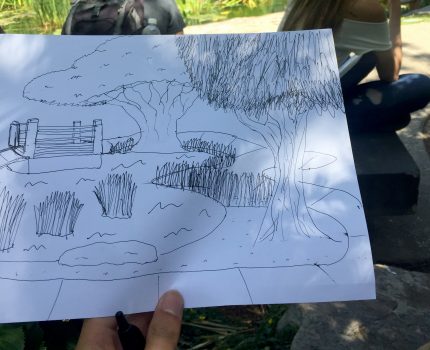
Sketching
This week we meet at the CSULB EBM Japanese Garden.
Materials
- Something to draw with. Anything works. Pencils are better. The greatest pencil I’ve ever used is the Draughting Pencil. You can get one in the CSULB Art Store in FA3 for a dollar or two.
- Paper. Maybe a sketch pad. Lined paper will work if it has to, but unlined paper is much better.
Rule #1: No Erasing!
Erasers like to act all sweet like they’re your friends and they only want to help you make better sketches. Don’t fall for this lie!
Erasers only want to mess you up!
Don’t think of some perfect line that you just failed to draw. Think of accumulations of lines that start to add up to creating 3D volume on a 2D surface. If you’re trying to draw some curved volume, like an orange, and you make a line that’s too narrow, or too wide – it’s not a mistake or bad line – it’s just one of many lines that will accumulate to express the volume you’re trying to draw. Don’t solve a “bad” line with an eraser! Solve it with more lines! Keep drawing. Keep Drawing! Keep your pencil moving, build up a beautiful, diverse family of lines where every line is welcome and special and plays a part in your overall drawing!
- Don’t drown kittens.
- Don’t eat babies.
- Don’t use an eraser.
- Love all of your lines.
Rule #2 Look!
Drawing isn’t about having your head down to the paper. It is about looking at what you’re trying to draw. Don’t take a quick glance and say “ok, I get it” and then draw, draw, draw. When you do that you’re drawing the idea in your head, not the reality in front of you.
- Look, Draw, Look, Draw, Look, Draw, Repeat!
A. 10 30-second sketches
To get started, do 10 30-second sketches. They can be shorter than 30 seconds, but try not to go longer. You’re not trying to make anything great or impressive. It’s sort of like warming up before a sports activity. You’re just trying to get your pencil moving. If you’re drawing the pond for example, maybe make a long horizontal line for the water’s surface. Then sketch a few plants growing up. A few rough fish or plant shapes beneath.
- Be fast
- Be loose
- Be sketchy
- Embrace an Impressionistic quality
B. 5-minute sketch
Next step, find something you’d like to draw for a little longer. Still don’t worry about this being a masterpiece, just try to sync up what your eye sees in the garden with the way your hand moves on the paper.
C-1. 5-minute Contour Drawing – Your Hand
With a Contour Drawing or a Blind Contour Drawing you try to coordinate hand and eye. Kind of like a young kid dribbling a basketball on the driveway for hours, teaching herself hand-eye coordination.
- Put your sketch pad on your lap (or someplace convenient)
- Pencil in one hand on paper
- Other hand lifted so you can look at it
- Pick a starting point, maybe the tip of your index finger. Put your eye on that point of your hand, and your pencil at a corresponding point on your paper.
- Now slowly try to move your eye and pencil in sync. As your eye moves down one finger and up the next, let your pencil do the same on the paper.
- Try not to look at your paper! – just let your hand and eye move. Trust that something will be on the paper when your’e done. Don’t worry about it coming out perfectly.
C-2. 5-minute Contour Drawing – The Garden
Do another Contour / Blind Contour drawing. This time pick any scene you like in the garden.
D-1. Representation
For 3 sketches try to draw something that looks like something. Again, don’t stress about skill. But try to make leaves look like leaves, and so on.
D-2. Abstraction
For 3 sketches try to use the elements in the garden as source images for an abstract drawing.
A drawing can be “abstract” in that it is stylized or removed a little, or a lot, from the original. You might draw a pile of twigs or reflections on the water. The don’t have to be completely unrecognizable to be “abstract”. They can be “somewhat abstract”. Or you could be very abstract and use the source inspiration to create a sketch that most people wouldn’t know where it came from.
E. Final Sketches
Use any time you have left to draw scenes from the garden. Long or short time. Abstract or Representational as you like.
Blog Post
Pick a few of your sketches to post on your blog. Write about your experience.



Comments? Questions? What great art did you see, make, or experience today?